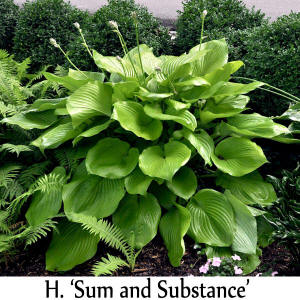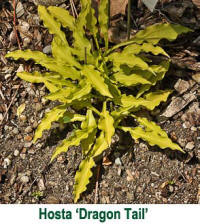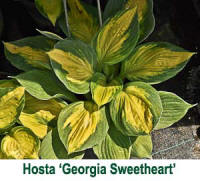 More
than once, I have had people visit my garden and be astonished
at the size of a specimen of H. 'Sum
and Substance'. Invariably they would ask, "What do you feed
it to make it so big?" Well, that question tells me two things
about the questioner.
More
than once, I have had people visit my garden and be astonished
at the size of a specimen of H. 'Sum
and Substance'. Invariably they would ask, "What do you feed
it to make it so big?" Well, that question tells me two things
about the questioner.
One is that
they don't know that we do not "feed" plants the way we would
feed a pet dog or a pig. Plants feed themselves through photosynthesis
and use nutrients as part of the building blocks along with
water, light, chlorophyll, carbon dioxide and the proper
temperature. Without an adequate level of all of these factors,
the plant will not grow no matter how much fertilizer you apply.
The second
thing it tells me is that they are not aware that there are
different size hostas. H. 'Sum
and Substance' grows that large because that is how big it
is supposed to be based on its genetic makeup. That is why it is
classified as a Giant size hosta.
 For
registration purposes, there are currently 5 size categories
including Giant,
Large, Medium,
Small and
Miniature. Until fairly recently, there was
also a Dwarf category but that has been dropped. The
measurements that determine which category applies include the
width and height of a mature clump i.e. generally 5 to 6 years
of age.
For
registration purposes, there are currently 5 size categories
including Giant,
Large, Medium,
Small and
Miniature. Until fairly recently, there was
also a Dwarf category but that has been dropped. The
measurements that determine which category applies include the
width and height of a mature clump i.e. generally 5 to 6 years
of age.
Mr. PGC
Comment: This is the standard set by
The American Hosta
Society registration form. However, the glossary of the
AHS
website also includes a measurement for leaf area in square
inches as part of the delineation.
The
American Hosta
Growers Association is in the process of updating the
specifications that relate to the various size classifications.
Once these are finalized and are adopted, they will become the
official size categories for The American Hosta Society. For
now, these are the guidelines for size categories:

 Of course, just
like all of the other measurement dependent traits listed about
hostas, they may vary considerably depending on the age of the
clump, growing environment, etc. In his vast experience with
hostas,
Mark Zilis reported at the 2010 Hosta Scientific Meeting
that the tallest hosta he has measured was a specimen of H. 'Sum
and Substance' which was 48 inches tall. A plant of H. 'Solar
Flare' that he encountered had a clump 10 feet wide while an
H. 'Empress
Wu" leaf measured 22.75 inches long with a surface area of
339 square inches. Those are whopper plants which have probably
been growing undisturbed for decades.
Of course, just
like all of the other measurement dependent traits listed about
hostas, they may vary considerably depending on the age of the
clump, growing environment, etc. In his vast experience with
hostas,
Mark Zilis reported at the 2010 Hosta Scientific Meeting
that the tallest hosta he has measured was a specimen of H. 'Sum
and Substance' which was 48 inches tall. A plant of H. 'Solar
Flare' that he encountered had a clump 10 feet wide while an
H. 'Empress
Wu" leaf measured 22.75 inches long with a surface area of
339 square inches. Those are whopper plants which have probably
been growing undisturbed for decades.



